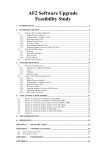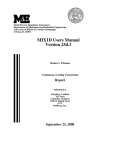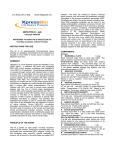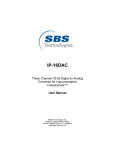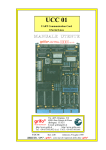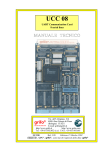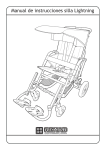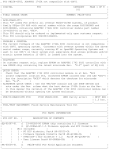Download IP-OCTAL-232
Transcript
IP-OCTAL-232 Eight Channel RS-232 IndustryPack™ ©1999, 2005 SBSTechnologies, Inc. Subject to change without notice. Hardware Revision: B Part # 89002067 Rev. 1.0 20050119 IP-OCTAL-232 Eight Channel RS-232 IndustryPack™ SBS Tecnologies, Inc 1284 Corporate Center Drive St. Paul, MN 55121 Tel (651) 905-4700 FAX (651) 905-4701 Email: [email protected] ©1999, 2005 SBS Technologies, Inc. IndustryPack is a registered trademark of SBS Technologies, Inc. QuickPack, SDpacK and Unilin are trademarks SBS Technologies, Inc. PC•MIP is a trademark of SBS Technologies, Inc. and MEN Mikro GmbH. SBS Technologies, Inc acknowledges the trademarks of other organizations for their respective products mentioned in this document. All rights are reserved: No one is permitted to reproduce or duplicate, in any form, the whole or part of this document without the express consent of SBS Technologies. This document is meant solely for the purpose in which it was delivered. SBS Technologies reserves the right to make any changes in the devices or device specifications contained herein at any time and without notice. Customers are advised to verify all information contained in this document. The electronic equipment described herein generates, uses, and may radiate radio frequency energy, which can cause radio interference. SBS Technologies assumes no liability for any damages caused by such interference. SBS Technologies’ products are not authorized for use as critical components in medical applications such as life support equipment, without the express consent of the president of SBS Technologies, Inc. This product has been designed to operate with IndustryPack, PC•MIP or PMC modules or carriers and compatible user-provided equipment. Connection of incompatible hardware is likely to cause serious damage. SBS Technologies assumes no liability for any damages caused by such incompatibility. Table of Contents Product Description............................................................................................................... 5 VMEbus Addressing ............................................................................................................. 7 NuBus Addressing ................................................................................................................ 9 I/O Pin Assignments.............................................................................................................. 10 IndustryPack Logic Interface................................................................................................. 12 Programming......................................................................................................................... 13 ID PROM............................................................................................................................... 14 User Options ......................................................................................................................... 15 Construction and Reliability .................................................................................................. 16 Repair.................................................................................................................................... 17 Shunt Locations .................................................................................................................... 18 Specifications ........................................................................................................................ 19 List of Figures Figure 1 Simplified Block Diagram of IP-OCTAL-232 ............................................... 5 Figure 2 I/O Buffer Circuit ......................................................................................... 6 Figure 3 Register Map of SCC2698, Blocks A and B ............................................... 7 Figure 4 Register Map of SCC2698, Blocks C and D............................................... 8 Figure 5 I/O Pin Assignment ..................................................................................... 10 Figure 6 Logic Interface Pin Assignment .................................................................. 12 Figure 7 Location of the Vector Register .................................................................. 13 Figure 8 ID PROM Data (hex)................................................................................... 14 Figure 9 Strobe Connection Options......................................................................... 15 Figure 10 DMA Shunt Assignments ............................................................................ 15 Figure 11 Shunt Locations .......................................................................................... 18 Product Description IP-OCTAL-232 is part of the Industry Pack™ family of modular I/O components. It is based around the Signetics CMOS SCC2698 Octal Universal Asynchronous Receiver/Transmitter. This component provides eight channels of full-duplex asynchronous serial communications, baud rate generators, state change detect logic, and four 16-bit counter/timers. A block diagram of the IP-OCTAL-232 is shown below in Figure 1. RS-232-C communication levels are provided by CMOS MC14C88 and MC14C89 transmitters and receivers. Five signals for each channel on the RS-232-C interface are supported: Transmit Data (TxD), Receive Data (RxD), Ready-To-Send (RTS), Clear-ToSend (CTS) and ground. The MC14C89 Receivers are biased at 1.5 volts nominally to permit a variety of input signal levels to be received without additional interface circuitry. The interface circuit is shown below in Figure 2. Protection diodes are provided in the ±12 volt supply lines to permit connection to powered equipment, even if the IndustryPack is unpowered. Vectored interrupts are fully supported. A common 8-bit vector register is provided. Channels a,b,c,d interrupt on IRQ0. Channels e,f,g,h interrupt on IRQ1. One of eight Channels Octart 8 SCC2698B Logic Interface ID PROM RS-232-C Control PAL Eight general purpose inputs Vector Register Figure 1 Simplified Block Diagram of IP-OCTAL-232 5 +12V From Octart RS-232-C Signal Out –12V To Octart RS-232-C Signal In 22Kž –12V Figure 2 I/O Buffer Circuit DMA is supported on channels c and d. If DMA is used, then the Request-To-Send lines on these two channels are not available . The IndustryPack is controlled by a single CMOS 22V10 type PAL. Connection to the IP-OCTAL-232 is via a standard 50-conductor ribbon cable. An optional connection panel is available which provides a 50-pin flat cable input with 16 DB9 male or female connectors. The metal reinforced connection panel mounts in a standard 19 inch rack-mount space. If compatibility with pre-1994 IP-OCTAL-232 IndustryPacks is required or for RS232D environments requiring a higher level of noise immunity, a special order option, Option01, is available which shifts the nominal threshold slightly less than one volt. This option does not provide TTL switching thresholds. Reprints of the Data Sheets for the SCC2698B, Schematic and PAL equations, and sample serial cables are available. 6 VMEbus Addressing IP-OCTAL-232 is accessed using 8-bit bytes at odd locations only. It is usually accessed in the I/O space. Shown below in Figures 3 and 4 are the register maps of the IP-OCTAL-232. All addresses are offsets from the I/O base address of the IP as set on the IP carrier board. The SCC2698B Octal UART has four major internal sections, called functional blocks A through D. Each functional block has two serial channels, one timer, and one I/O port. Hex Dec Binary 1 3 5 7 9 B D F 11 13 15 17 19 1B 1D 1F 1 3 5 7 9 11 13 15 17 19 21 23 25 27 29 31 Functional Block A 0000001 MR1a, MR2a 0000011 SRa 0000101 RESERVED 0000111 RHRa 0001001 IPCRA 0001011 ISRA 0001101 CTUA 0001111 CRLB 0010001 MR1b, MR2b 0010011 SRb 0010101 RESERVED 0010111 RHRb 0011001 RESERVED 0011011 INPUT PORT A 0011101 START C/T A 0011111 STOP C/T A MR1a, MR2a CSRa CRa THRa ACRA IMRA CTURA CTLRB MR1b, MR2b CSRb CRb RHRb RESERVED OPCRA RESERVED RESERVED 21 23 25 27 29 2B 2D 2F 31 33 35 37 39 3B 3D 3F 33 35 37 39 41 43 45 47 49 51 53 55 57 59 61 63 Functional Block B 0100001 MR1c, MR2c 0100011 SRc 0100101 RESERVED 0100111 RHRc 0101001 IPCRB 0101011 ISRB 0101101 CTUB 0101111 CRLB 0110001 MR1d, MR2d 0110011 SRd 0110101 RESERVED 0110111 RHRd 0111001 RESERVED 0111011 INPUT PORT B 0111101 START C/T B 0111111 STOP C/T B MR1c, MR2c CSRc CRc THRc ACRB IMRB CTURB CTLRB MR1d, MR2d CSRd CRd THRd RESERVED OPCRB RESERVED RESERVED Figure 3 Read Write Register Map of SCC2698, Blocks A and B 7 Hex Dec Binary 41 43 45 47 49 4B 4D 4F 51 53 55 57 59 5B 5D 5F 65 67 69 71 73 75 77 79 81 83 85 87 89 91 93 95 Functional Block C 1000001 MR1e, MR2e 1000011 SRe 1000101 RESERVED 1000111 RHRe 1001001 IPCRC 1001011 ISRC 1001101 CTUC 1001111 CRLC 1010001 MR1f, MR2f 1010011 SRf 1010101 RESERVED 1010111 RHRf 1011001 RESERVED 1011011 INPUT PORT C 1011101 START C/T C 1011111 STOP C/T C MR1e, MR2e CSRe CRe THRe ACRC IMRC CTURC CTLRC MR1f, MR2f CSRf CRf THRf RESERVED OPCRC RESERVED RESERVED 61 63 65 67 69 6B 6D 6F 71 73 75 77 79 7B 7D 7F 97 99 101 103 105 107 109 111 113 115 117 119 121 123 125 127 Functional Block D 1100001 MR1g, MR2g 1100011 SRg 1100101 RESERVED 1100111 RHRg 1101001 IPCRD 1101011 ISRD 1101101 CTUD 1101111 CRLD 1110001 MR1h, MR2h 1110011 SRh 1110101 RESERVED 1110111 RHRh 1111001 RESERVED 1111011 INPUT PORT D 1111101 START C/T D 1111111 STOP C/T D MR1g, MR2g CSRg CRg THRg ACRD IMRD CTURD CTLRD MR1h, MR2h CSRh CRh RHRh RESERVED OPCRD RESERVED RESERVED Figure 4 Read Write Register Map of SCC2698, Blocks C and D For NuBus applications see the section following, Nubus Addressing. 8 NuBus Addressing Since the Nubus uses only 32-bit wide accesses, 8-bit wide peripherals such as the IPOCTAL-232 appear in the host address space every fourth byte. To calculate the RM1260 Springboard register addresses from the VMEbus address (given in the previous section in Figures 4 and 5), multiply by two and subtract one. To convert VME addresses to RM1270 SupportBoard addresses multiply by two and add one. 9 I/O Pin Assignments This section gives the pin assignments for IP-OCTAL-232 connections. Pin Number Channel Function Level 1 2 3 4 5 Channel a Channel a Channel a Channel a Channel a GND TxD RxD RTS CTS RS-232-C RS-232-C RS-232-C RS-232-C RS-232-C 6 7 8 9 10 Channel b Channel b Channel b Channel b Channel b GND TxD RxD RTS CTS RS-232-C RS-232-C RS-232-C RS-232-C RS-232-C 11 12 13 14 15 Channel c Channel c Channel c Channel c Channel c GND TxD RxD RTS CTS RS-232-C RS-232-C RS-232-C RS-232-C RS-232-C 16 17 18 19 20 Channel d Channel d Channel d Channel d Channel d GND TxD RxD RTS CTS RS-232-C RS-232-C RS-232-C RS-232-C RS-232-C 21 22 23 24 25 Channel e Channel e Channel e Channel e Channel e GND TxD RxD RTS CTS RS-232-C RS-232-C RS-232-C RS-232-C RS-232-C 26 27 28 29 30 Channel f Channel f Channel f Channel f Channel f GND TxD RxD RTS CTS RS-232-C RS-232-C RS-232-C RS-232-C RS-232-C 31 32 33 34 35 Channel g Channel g Channel g Channel g Channel g GND TxD RxD RTS CTS RS-232-C RS-232-C RS-232-C RS-232-C RS-232-C 36 Channel h 37 Channel h 38 Channel h 39 Channel h Channel h GND TxD RxD RTS CTS RS-232-C RS-232-C RS-232-C RS-232-C 40 RS-232-C 41 42 --- GND +12 pullup -RS-232-C 43 44 45 46 47 48 49 50 Channel a Channel b Channel c Channel d Channel e Channel f Channel g Channel h MPI - a MPI - b MPI - c MPI - d MPI - e MPI - f MPI - g MPI - h CMOS* CMOS* CMOS* CMOS* CMOS* CMOS* CMOS* CMOS* *Note: I/O lines on pins 43–50 are ±50 µA input current, TTL thresholds. Figure 5 I/O Pin Assignment 10 Each channel has five RS-232-C lines. Each channel is wired identically at the 50-pin connector. The five lines are Ground, Transmit Data output, Receive Data input, Ready to Send output, and Clear to Send input. The common ground line for all channels connects to the local logic ground. There are many programming options. The two “modem control lines” RTS and CTS may also be used for other modem or terminal control functions or for general purpose functions. There is a pullup resistor (1KΩ) to +12 volts available on pin 42. This may be connected externally to assert a “Mark” (true) signal into an RS-232-C line. Eight general purpose input lines at non-RS-232 levels are provided on pins 43 through 50. These are unbuffered CMOS logic inputs connected directly to the SCC2698B. They may be programmed as general purpose inputs or as the counter/timer external input. The switching threshold for inputs is at TTL levels (1.5 volts nominal). Since these lines are unbuffered, the user is cautioned to observe anti-static rules in handling cabling, the IndustryPack and all connecting hardware. External equipment connected to these lines should be powered up and down at the same time as the IndustryPack. 11 IndustryPack Logic Interface Pin Assignment Figure 6 below gives the pin assignments for the IndustryPack Logic Interface on the IPOCTAL-232. Pins marked n/c below are defined by the specification, but not used on IPOCTAL-232. GND CLK Reset* D0 D1 DMAReq0 D2 D3 DMAReq1 D4 D5 DMAck0* D6 D7 DMAck1* n/c n/c n/c n/c n/c n/c n/c n/c n/c BS1* –12V +12V +5V GND GND +5V R/W* IDSel* 5 30 MEMSel* 7 32 INTSel* 9 34 IOSel* 11 36 A1 n/c A2 n/c A3 n/c A4 n/c A5 Strobe* A6 Ack* n/c GND 1 26 2 3 28 4 29 6 31 8 33 10 35 12 13 38 14 15 40 16 17 42 18 19 44 20 21 46 22 23 48 24 25 50 37 Note 1: The no-connect (n/c) signals above are defined by the IndustryPack Logic Interface Specification, but not used by this IP. See the Specification for more information. Note 2: The layout of the pin numbers in this table corresponds to the physical placement of pins on the IP connector. Thus this table may be used to easily locate the physical pin corresponding to a desired signal. Pin 1 is marked with a square pad on the IndustryPack. Figure 6 Logic Interface Pin Assignment 12 27 39 41 43 45 47 49 Programming The IP-OCTAL-232 is designed around the SCC2698B and all of the SCC2698 functions are available. The SCC2698B is divided into four Functional Blocks lettered A through D. Each functional block contains two serial channels. The channels are identified by lower case letters a through h. The SCC2698B contains 64 internal registers, 16 for each functional block. Each of these registers are accessible using a read or write to the IP-OCTAL-232 I/O space. The SCC2698 manual is included with the Technical Documentation to provide the user with detailed information about these registers. The IndustryPack provides an external vector register. The address of the vector register, which may also be read normally, is in the upper half of the ID PROM space of the IndustryPack, on odd bytes. The address offsets are shown in Figure 7. There is also provision for mapping the vector register to IP memory space. This is required primarily when the IP is installed on a Motorola MVME162 CPU board. In this mode, no address offset is required; the memory base address is sufficient. Carrier Bus Address VIPC310 VIPC610 VMEbus VMEbus IP I/O base + $C1 IP I/O base + $C1 MVME162 IPIC IP Memory base RM1260 RM1270 NuBus NuBus IP ID base + $81 IP ID base + $83 Figure 7 Location of the Vector Register The eight bit vector is loaded by the host software prior to enabling interrupts. The interrupts service routine polls the SCC2698B to determine the detailed cause of the interrupt. Function Blocks A and B interrupt on IRQ0. Function Blocks C and D interrupt on IRQ1. See the User Manual for your IP Carrier tor interrupt mapping to your bus. Note that although two distinct interrupt levels are provided, there is a single vector for the IndustryPack. A Hypercard stack is available that permits quick demonstration, testing and prototyping of the IP-OCTAL-232. A user provided Apple® Macintosh® II family computer is required. 13 ID PROM Every IP contains an IP PROM, whose size is at least 32 x 8 bits. The ID PROM aids in software auto configuration and configuration management. The user's software, or a supplied driver, may verify that the device it expects is actually installed at the location it expects, and is nominally functional. The ID PROM contains the manufacturing revision level of the IP. If a driver requires that a particular revision be present, it may check for it directly. Standard data in the ID PROM on the IP-OCTAL-232 is shown in Figure 8 below. For more information on IP ID PROMs refer to the IndustryPack Logic Interface Specification. The location of the ID PROM in the host's address space is dependent on which carrier is used. Normally for VMEbus carriers the ID PROM space is directly above the IP's I/O space, or at IP-base + $80. Macintosh drivers use the ID PROM automatically. RM1260 address may be derived from Figure 8 below by multiplying the addresses given by two, then subtracting one. RM1270 addresses may be derived by multiplying the addresses given by two, then adding one. The ID PROM used is an AMD 27LS19A. 3F (available for user) 19 17 15 13 11 0F 0D 0B 09 07 05 03 01 CRC No of bytes used Driver ID, high byte Driver ID, low byte reserved Revision Model No IP-OCTAL-232 Manufacturer ID GreenSpring ASCII "C" ASCII "A" ASCII "P" ASCII "I" Figure 8 ID PROM Data (hex) 14 (0B) (00) (A1) (22) (F0) (43) (41) (50) (49) User Options User options consist of connecting to the Strobe pin on the Logic Interface and connections to support DMA. The location of the shunt groups is shown near the end of this Manual in Figure 11. The Strobe pin on the Logic Interface (pin 46) is provided for secondary clock input or output. This pin may be driven by the Channel a Multi-Purpose Output from the SCC, or it may be connected to provide for the external input the to Counter/Timer. These options are shown below in Figure 9. Note that in most cases some corresponding programming of SCC modes is required. The SCC may be programmed to drive the connected pin for other functions that those listed in the Figure below. The IndustryPack Logic Interface Specification restricts the Strobe pin to clock functions, however. Only those functions listed below should programmed. Shunt E1 1-2 1-2 1-2 I/O Output Output Output SCC Pin MPOa MPOa MPOa 2–3 2–3 Input Input MPI1a MPI1a OUT none none Figure 9 Function Counter/Timer output Transmit Clock (1X or 16X) Receive Clock (1X or 16X) General Purpose Input Counter/Timer External Input Strobe Pin floating default Strobe Connection Options The IP-OCTAL-232 is configured to support minimum Direct Memory Access (DMA) on Channels C and D. To use DMA, program the SCC for TxRDY or RxRDY on MPOc and/or MPOd. See Figure 10 below for DMA Shunt Assignments. Shunt E2 IN E3 IN E2,E3 OUT SCC Pin MPOc MPOd -- Logic Pin DMAReq0 DMAReq1 -- Figure 10 Function TxRDY or RxRDY TxRDY or RxRDY No DMA default DMA Shunt Assignments 15 Construction and Reliability IndustryPacks were conceived and engineered for rugged industrial environments. The IP-OCTAL-232 is constructed out of 0.062 inch thick FR4 material. The six copper layers consist of a ground plane, a power plane and four signal planes. Surface mounting of components is used extensively. IC sockets for the control PAL and ID PROM use gold plated screw-machined pins. High insertion and removal forces are required, which assists in keeping components in place. If the application requires unusually high reliability or is in an environment subject to high vibration, the user may solder the four corner pins of each socketed IC into the socket, using a grounded soldering iron. The IndustryPack connectors are keyed, shrouded and gold plated on both contacts and receptacles. They are rated at 1 Amp per pin, 200 insertion cycles minimum. These connectors make consistent, correct insertion easy and reliable. The IP is optionally secured to the carrier with four metric M2 stainless steel screws. The heads of the screws are countersunk into the IP. The four screws provide significant protection against shock, vibration, and incomplete insertion. For most applications they are not required. The IndustryPack provides a low temperature coefficient of 0.89 W/°C for uniform heat. This is based on the temperature coefficient of the base FR4 material of .31 W/m-°C, and taking into account the thickness and area of the IP. This coefficient means that if 0.89 Watts is applied uniformly on the component side, that the temperature difference between the component and the solder side is one degree Celsius. 16 Repair Service Policy Before returning a product for repair, verify as well as possible that the suspected unit is at fault. Then call the Customer Service Department for a RETURN MATERIAL AUTHORIZATION (RMA) number. Carefully package the unit, in the original shipping carton if this is available, and ship prepaid and insured with the RMA number clearly written on the outside of the package. Include a return address and the telephone number of a technical contact. For out-of-warranty repairs, a purchase order for repair charges must accompany the return. SBS will not be responsible for damages due to improper packaging of returned items. For service on SBS products not purchased directly from SBS contact your reseller. Products returned to SBS for repair by other than the original customer will be treated as out-of-warranty. 17 Shunt Locations OSC SCC2698B E1 E2 E3 Figure 11 Shunt Locations 18 Specifications Logic Interface IndustryPack logic Interface Wait States Zero on ID and Interrupts, One on SCC accesses Number of Channels Eight Type of Channels Full-duplex asynchronous RS-232C Baud Rates 18 fixed rates from 50 to 38.4K Four user-defined rates using timers Implemented Signals TxD, RxD, RTS, CTS, GND Stop Bits 1, 1.5, 2 in 1/16 bit increments Clock Source Local crystal oscillator, or external Error Detection Parity, framing, overrun, false start bit, break Channel Modes Full duplex, automatic echo, local loopback, remote loopback Number of Timers Four Type of Timers 16-bit, multi-function, programmable Interrupt Sources 32, maskable, vectored Interrupt Vector Eight bits, may be independently read/writable Auxiliary Input lines Eight TTL/CMOS inputs, programmable bit input or state change detect causes interrupt or counter/external clock input IP Strobe Options Timer output, or baud rate clock input, or none Power Requirements +5 VDC, 170 mA +12 VDC, 22 mA –12 VDC, 9 mA Dimensions 1.800 by 3.900 by 0.340 inches maximum Environmental Operating temperature: +10° to +50°C Humidity: 5% to 95% non-condensing Storage: –10° to +85°C 19





















